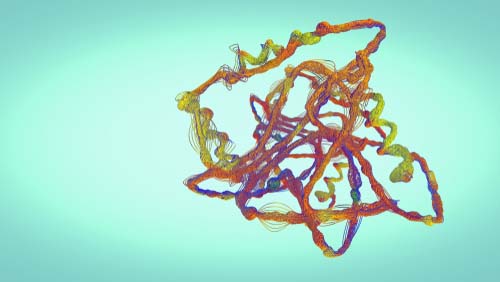Proteins and Peptides
Peptides are produced by all living things and assume a wide range of identities and functions depending on their amino acid composition, including:

- Antibiotic/antifungal
- Venoms
- Oncological
- Immune/inflammatory
- Neurochemical
- Endocrine
- Cardiovascular
- Gastrointestinal
- Renal
- Respiratory
In addition to the many other roles peptides play within these systems, they've been identified as agents of intercellular communication. These short, secreted peptides are taken up through the membranes of receiving cells where they convey information about the physiochemical states of their origin cells. Many such signal peptides can exist in the same organism; in the fully sequenced genome of the flowering plant Arabidopsis thaliana, for example, over 1000 potential signal peptides have been identified, most of them not yet characterized.
Proteins are polypeptides long and complex enough to form folded three-dimensional structures and perform more sophisticated functions than shorter peptides. Together with carbohydrates, lipids and nucleic acids, proteins are designated as macromolecular biomolecules — substances essential to one or more fundamental biological processes.
Like their smaller peptide counterparts, proteins perform a vast array of functions that depend on their amino acid sequence and structure. Understanding how proteins are structured is essential to understanding how they can perform such a variety of tasks, from forming the flagella used by swimming bacteria to regulating blood sugar levels in mammals.
Protein structure is defined on four levels:
- Primary structure is the amino acid sequence of a protein from beginning to end (N-terminus to C-terminus)
- Secondary structure forms when amino acids along the chain interact to make the chain bend or fold into nonlinear shapes (such as the α helix and the β pleated sheet)
- Tertiary structure of a protein results from interactions among the R-groups attached to an amino acid chain (such as ionic bonds, hydrogen bonds, disulfide bridges and hydrophobic interactions)
- Quaternary structure applies to proteins with multiple polypeptide chains, or subunits, that join together to form a single protein (such as hemoglobin, made from four separate subunits)
Isolation of proteins
Because the chemical and physical properties of proteins vary, they can be isolated from one another for subsequent analysis by several commonly used methods:
- Centrifugation – A protein's mass and shape give it a specific rate of sedimentation under high g-forces, allowing separation
- Gel electrophoresis – Polypeptide chains of different molecular weights migrate through a gel matrix (such as polyacrylamide) at different rates when an electric field is applied
- Liquid chromatography – Proteins are separated based on their movement through a column containing spherical beads. Liquid chromatography allows separation by mass (gel filtration column), charge (ion-exchange column) and ligand-binding behavior (affinity column)

